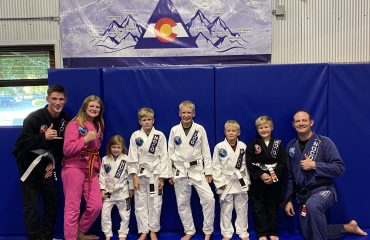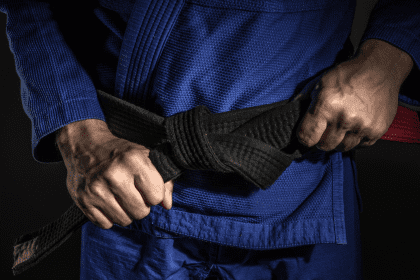
In our busy lives, maintaining fitness and learning practical self-defense skills are crucial. NOCO Jiu Jitsu and Self Defense provide an ideal platform to achieve both. Their comprehensive jiu-jitsu training programs cater to all ages and skill levels, focusing on physical fitness and self-defense. This article explores how jiu-jitsu training can transform your fitness and self-defense skills, offering numerous physical, mental, and social benefits. Let’s delve into the core principles and many advantages of incorporating jiu-jitsu into your life.
Brazilian Jiu-Jitsu, often referred to as BJJ, is a highly effective martial art that emphasizes ground fighting and submission techniques. Learning Brazilian Jiu-Jitsu can significantly enhance your overall fitness and provide you with practical self-defense skills. Additionally, BJJ has become an integral part of mixed martial arts (MMA), making it a valuable discipline for those interested in combat sports.
What Are the Core Principles of Jiu-Jitsu Training?
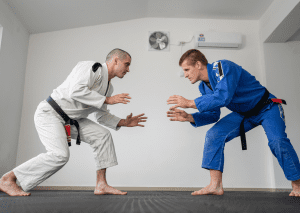
Understanding leverage and technique over strength
In jiu-jitsu training, the focus is on using leverage and technique rather than relying on brute strength. This principle allows practitioners of all sizes and strengths to effectively control and submit their opponents. By mastering these techniques, you can learn to overcome physical disadvantages and develop a more strategic approach to self-defense and martial arts.
In Brazilian Jiu Jitsu, practitioners learn to utilize various BJJ positions such as the half guard, butterfly guard, and closed guard to gain an advantage over their opponents. These positions form the foundation of BJJ and are essential for both sport BJJ and self-defense applications. Pioneers of Brazilian Jiu-Jitsu, developed these techniques to allow smaller individuals to defend themselves against larger attackers effectively.
The significance of discipline and consistency
Discipline and consistency are crucial in jiu-jitsu training. Regular practice helps improve your skills, build muscle memory, and maintain fitness levels. Consistency in training also fosters mental resilience and a disciplined mindset, which are beneficial both on and off the mat.
As you progress in learning Brazilian Jiu-Jitsu, you’ll develop a deep understanding of body position and how to maintain a dominant position against your opponents. This knowledge is invaluable not only in BJJ competitions but also in real-life self-defense situations. BJJ athletes often spend years perfecting their techniques and strategies, demonstrating the importance of long-term commitment to the art.
How Does Jiu-Jitsu Training Improve Physical Fitness?
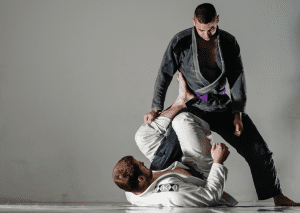
Enhancing cardiovascular health
Jiu-jitsu training involves intense physical activity that significantly boosts cardiovascular health. The continuous movement and exertion required in training sessions enhance heart rate and improve overall cardiovascular endurance. Brazilian Jiu-Jitsu training often includes drills that simulate real-world grappling scenarios, providing an excellent cardiovascular workout.
These drills can involve transitions between various BJJ positions, such as moving from half guard to butterfly guard or attempting to escape from traditional side control. The dynamic nature of these movements ensures that practitioners are constantly challenging their cardiovascular system.
Building muscle strength and endurance
Practicing Brazilian jiu-jitsu requires engaging various muscle groups, which helps in building strength and endurance. Techniques like joint locks, throws, and holds require significant physical effort, contributing to muscle development and overall physical strength.
BJJ training often involves working with a sparring partner, which provides resistance and helps develop functional strength. Practitioners frequently use their upper body to control their opponent’s movements, while also engaging their core and lower body to maintain balance and leverage. This full-body workout leads to improved overall strength and muscular endurance.
Improving flexibility and balance
Flexibility and balance are essential components of jiu-jitsu training. Regular practice helps in increasing flexibility through various stretches and movements, while balance is developed through maintaining and transitioning between different positions during sparring and drills.
In Brazilian Jiu-Jitsu, practitioners learn to adapt to various body positions, including the belly position and inverted positions. These unconventional postures challenge and improve flexibility and balance. Additionally, BJJ techniques often require practitioners to use their left arm, right arm, left side, and right foot in coordination, further enhancing overall body awareness and balance.
What Are the Mental Benefits of Jiu-Jitsu Training?
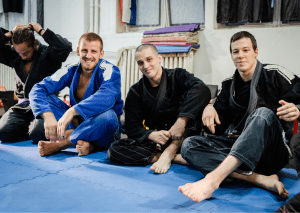
Boosting mental resilience and focus
Jiu-jitsu training enhances mental resilience by challenging practitioners to think strategically under pressure. This training sharpens focus and concentration, helping you stay calm and composed in stressful situations.
Brazilian Jiu-Jitsu requires constant problem-solving and adaptation, as practitioners must anticipate their opponent’s moves and plan several steps ahead. This mental chess game helps develop cognitive flexibility and decision-making skills under pressure. Moreover, the challenge of learning complex techniques and strategies in BJJ can significantly boost mental resilience and perseverance.
Reducing stress and promoting mental clarity
Engaging in martial arts like Brazilian jiu-jitsu can be an excellent stress reliever. The physical exertion and mental engagement required during training sessions help reduce stress levels and promote mental clarity.
The focused nature of BJJ training allows practitioners to temporarily set aside daily worries and concentrate fully on the present moment. This mindfulness aspect of Brazilian Jiu-Jitsu can lead to improved overall mental well-being and reduced anxiety. Additionally, the sense of accomplishment from mastering new techniques or performing well in BJJ competitions can boost self-esteem and confidence.
Developing problem-solving skills
Jiu-jitsu is often likened to a game of chess, where each move must be carefully considered and countered. This aspect of training helps develop problem-solving skills and encourages creative thinking.
In Brazilian Jiu-Jitsu, practitioners must constantly adapt to their opponent’s movements and find solutions to complex positional puzzles. This problem-solving extends beyond the mat, as BJJ practitioners often find themselves applying the same analytical thinking to challenges in their personal and professional lives. The ability to remain calm and think clearly under pressure is a valuable skill that translates well to many aspects of life.
How Can Jiu-Jitsu Training Enhance Your Self-Defense Skills?

Learning effective techniques for real-life situations
Jiu-jitsu training focuses on practical techniques that can be used in real-life self-defense situations. Techniques such as the cross collar choke and maintaining control in the back mount position are effective for neutralizing threats.
Brazilian Jiu-Jitsu emphasizes fundamental techniques that can be applied in various scenarios, including against larger opponents. Practitioners learn to use leverage and techniques to overcome size and strength disadvantages. BJJ also teaches valuable grappling styles that are effective in close-quarters combat, making it an excellent choice for practical self-defense. Additionally, learning Brazilian Jiu-Jitsu helps develop the ability to remain calm and composed in high-stress situations, which is crucial for effective self-defense.
Gracie jiu-jitsu is a specific self-defense system developed by the Gracie family, focusing on ground fighting and leverage.
Understanding situational awareness
Training in Brazilian jiu-jitsu helps improve situational awareness. Practitioners learn to be more aware of their surroundings and potential threats, which is a critical aspect of self-defense. BJJ training often includes drills that simulate real-world scenarios, helping students develop a keen sense of their environment. This heightened awareness extends beyond the mat, making practitioners more attuned to potential dangers in everyday life. Moreover, Brazilian Jiu-Jitsu teaches students to assess threats quickly and make split-second decisions, which is invaluable in self-defense situations.
Building confidence in personal safety
Knowing that you have the skills to defend yourself can significantly boost your confidence. Jiu-jitsu training provides this assurance by teaching effective self-defense techniques and building physical and mental strength.
As practitioners progress through the belt system in BJJ, from white belt to blue belt and beyond, they gain increasing confidence in their abilities. This confidence is not just about physical skills but also about the mental fortitude developed through consistent training. Brazilian Jiu-Jitsu also teaches students to remain calm under pressure, which is crucial in real-life confrontations. Furthermore, the community aspect of BJJ provides a support network that further enhances personal confidence and security.
What Role Does Sparring Play in Jiu-Jitsu Training?
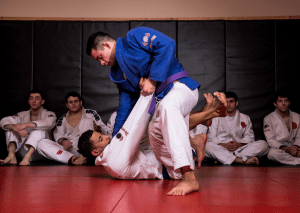
Practical application of techniques
Sparring, or rolling, is a vital part of jiu-jitsu training. It allows practitioners to apply techniques in a controlled environment, testing their skills and improving their effectiveness. In Brazilian Jiu-Jitsu, sparring sessions provide opportunities to practice various BJJ positions such as half guard, butterfly guard, and closed guard against resisting opponents. These live training sessions help students understand the nuances of timing, leverage, and strategy in real-time. Additionally, sparring in BJJ helps practitioners develop a sense of how different techniques feel when applied with resistance, which is crucial for self-defense applications. During sparring, practitioners often return to the starting position on their knees after signaling submission.
Improving reaction times and adaptability
Through regular sparring sessions, practitioners enhance their reaction times and adaptability. These skills are crucial in both self-defense scenarios and competitive settings. BJJ sparring requires quick thinking and the ability to transition between different techniques and positions rapidly. Practitioners learn to recognize and capitalize on openings, improving their overall fight IQ. Furthermore, sparring in Brazilian Jiu-Jitsu helps develop the ability to remain calm and think clearly under pressure, which is invaluable in real-life self-defense situations.
Safe environment for testing skills
Sparring provides a safe and controlled environment for testing and refining techniques. It enables practitioners to learn from their mistakes and improve their skills without the risks associated with real-life confrontations.
In Brazilian Jiu-Jitsu, sparring partners work together to challenge each other while maintaining a safe training environment. This cooperative aspect of BJJ allows practitioners to push their limits and experiment with new techniques without fear of injury. Additionally, sparring helps students understand the importance of body position and how to maintain dominant positions against resisting opponents, which is crucial for both competition and self-defense.
How Does Jiu-Jitsu Training Foster a Sense of Community?
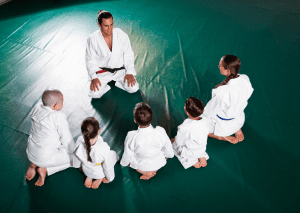
Building strong relationships through shared experiences
Training in Brazilian jiu-jitsu fosters a sense of community as practitioners bond over shared experiences and challenges. This camaraderie builds strong relationships and a supportive network. The intense nature of BJJ training often leads to deep friendships among practitioners who support each other’s growth. Brazilian Jiu-Jitsu academies typically foster a family-like atmosphere where students of all skill levels train together. This inclusive environment helps create lasting bonds that extend beyond the mat.
Encouraging teamwork and mutual respect
The cooperative nature of jiu-jitsu training encourages teamwork and mutual respect among practitioners. Training partners work together to improve their skills, fostering a sense of mutual respect and cooperation. In BJJ, students often rotate partners during training, allowing them to work with people of different sizes, strengths, and skill levels. This diversity promotes empathy and understanding among practitioners. Additionally, the hierarchical belt system in BJJ encourages respect for more experienced practitioners while also emphasizing the importance of helping lower-ranked students.
Finding support and motivation within the Jiu-Jitsu community
The jiu-jitsu community provides support and motivation, helping practitioners stay committed to their training. This sense of belonging and encouragement can be a significant factor in maintaining long-term engagement with the sport.
BJJ academies often organize social events, seminars, and BJJ competitions that strengthen community bonds. The shared goal of improvement and the collective celebration of individual achievements create a supportive environment that keeps practitioners motivated. Moreover, the global Brazilian Jiu-Jitsu community offers opportunities for networking and friendship beyond one’s local academy.
What Are the Long-Term Health Benefits of Jiu-Jitsu Training?
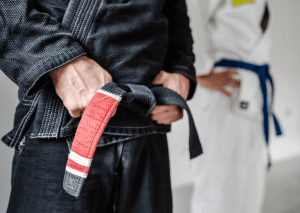
Maintaining cardiovascular health
Regular jiu-jitsu training helps maintain cardiovascular health by providing consistent aerobic exercise. This can help prevent heart-related issues and promote overall cardiovascular fitness. The training involves intense grappling sessions that elevate heart rate and improve endurance. The dynamic nature of BJJ, which includes transitions between various dominant positions, provides an excellent cardiovascular workout. Additionally, the constant movement and engagement in BJJ help burn calories and maintain a healthy weight, further contributing to heart health.
Preventing lifestyle-related illnesses
The physical activity involved in jiu-jitsu training can help prevent lifestyle-related illnesses such as obesity, diabetes, and hypertension. The combination of cardiovascular exercise and strength training promotes a healthy body.
BJJ engages the entire body, helping to build lean muscle mass and improve metabolism. The stress-relieving aspects of BJJ can also contribute to better mental health and reduced risk of stress-related illnesses. Furthermore, the discipline required for consistent BJJ training often translates to healthier lifestyle choices outside the gym.
Promoting longevity and overall well-being
Engaging in jiu-jitsu training contributes to overall well-being and longevity. The physical, mental, and social benefits of training collectively enhance quality of life and promote a healthier, longer life. Jiu Jitsu provides a lifelong pursuit of learning and self-improvement, keeping practitioners mentally engaged as they age. The BJJ community often includes practitioners of all ages, providing social connections and support throughout life. Moreover, the functional strength and flexibility developed through BJJ can help maintain mobility and independence in later years.
How Can Beginners Get Started with Jiu-Jitsu Training?

Finding the right gym and instructor
Beginners should start by finding a reputable gym and a qualified instructor. NOCO Jiu Jitsu and Self Defense offers excellent programs for all skill levels, ensuring a solid foundation in jiu-jitsu training. When learning Brazilian Jiu-Jitsu, it’s crucial to find an academy that emphasizes proper technique and safety. Look for instructors who have experience teaching beginners and can break down complex techniques into manageable steps. Many BJJ academies offer trial classes, allowing you to experience the training environment before committing.
Gracie Academy is a successful global enterprise with 250,000 members in 196 countries, offering courses on how to replicate their business success in teaching jiu-jitsu.
Understanding the basics of Jiu-Jitsu etiquette
New practitioners should learn the basics of jiu-jitsu etiquette, including proper attire (such as a jiu-jitsu gi), respectful behavior towards training partners, and maintaining hygiene. In BJJ, respect for training partners and the instructor is paramount. Beginners should familiarize themselves with basic BJJ terminology and the proper way to address instructors. Understanding the importance of tapping out when caught in a submission is crucial for safety. Additionally, learning about the different aspects of gi jiu jitsu versus no gi training can help newcomers decide which style they prefer.
Setting realistic goals and expectations
Setting realistic goals and expectations is crucial for beginners. Understanding that progress takes time and dedication helps in maintaining motivation and commitment to training. The advancement through the belt system from white belt to blue belt and beyond requires consistent effort and patience. Beginners should focus on learning fundamental techniques and basic BJJ positions before worrying about advanced moves. Setting small, achievable goals, such as mastering a specific technique or attending a certain number of classes per week, can help maintain motivation. Remember that everyone progresses at their own pace in BJJ, and consistent practice is key to improvement.
What Equipment Is Needed for Jiu-Jitsu Training?
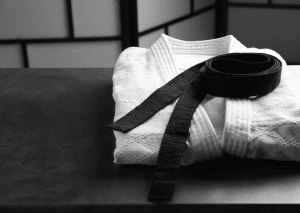
Essential gear for beginners
Beginners typically need a jiu-jitsu gi, a belt, and mouthguards. These items are essential for participating in training sessions and ensuring safety. For those starting the training, a good quality gi is crucial for gi jiu jitsu classes. Beginners should also invest in a sturdy mouthguard to protect their teeth during sparring sessions. Some academies may require additional protective gear such as knee pads or headgear. It’s also important to have a water bottle and towel for hydration and hygiene during training.
Advanced equipment for experienced practitioners
As practitioners advance, they might invest in additional gear such as rash guards, knee pads, and training dummies. These items can help enhance training and protect against injuries. Experienced BJJ practitioners often have multiple GIs for different training sessions or competitions. Some may invest in grappling dummies or punching bags for solo drills and technique practice at home. Advanced practitioners might also consider specialized gear for no-gi training, such as spats and fitted rash guards.
Maintenance and care of Jiu-Jitsu gear
Proper maintenance and care of jiu-jitsu gear are essential. Regular washing of the jiu-jitsu gi and other equipment ensures hygiene and extends the lifespan of the gear. In BJJ, cleanliness is crucial for preventing skin infections and maintaining a healthy training environment.
Practitioners should wash their gi after every training session and allow it to air dry completely. Regularly inspecting gear for wear and tear, such as loose stitching or frayed edges, is important for safety. Properly storing BJJ equipment in a dry, well-ventilated area can help prevent odors and extend its lifespan.
How Do Jiu-Jitsu Competitions Enhance Your Training?
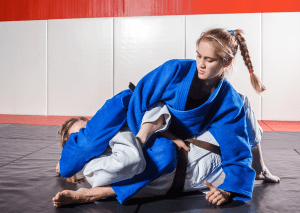
Preparing for competition mentally and physically
BJJ competitions require thorough mental and physical preparation. Training for competitions helps improve focus, endurance, and technique. Competing in tournaments pushes practitioners to refine their skills and develop a deeper understanding of BJJ positions and strategies. The intensity of competition preparation often leads to rapid improvement in both physical conditioning and technical proficiency. Mental preparation for competitions can involve visualization techniques, studying opponents’ styles, and developing game plans for different scenarios.
Learning from competitive experiences
Participating in competitions provides valuable learning experiences. Competing against different opponents helps identify areas for improvement and fosters growth. BJJ competitions expose practitioners to a wide variety of grappling styles and techniques they may not encounter in their regular training. This exposure can highlight weaknesses in one’s game and provide motivation for further improvement. The pressure of competition also helps develop mental toughness and the ability to perform under stress, which translates well to both self-defense situations and other aspects of life.
The benefits of setting and achieving competitive goals
Setting and achieving competitive goals can be highly rewarding. It provides a sense of accomplishment and motivates practitioners to continue improving their skills. In BJJ, competition goals might include placing in a tournament, successfully executing specific techniques, or earning positional points. Achieving these goals can boost confidence and provide tangible markers of progress. The process of working towards competitive goals often leads to improved discipline and focus in training, benefiting overall skill development. Additionally, success in competitions can open doors to new opportunities within the BJJ community, such as invitations to seminars or advanced training camps.
What Are Common Challenges Faced in Jiu-Jitsu Training?
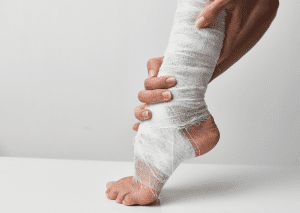
Overcoming plateaus in progress
Practitioners often face plateaus in their progress. Overcoming these challenges requires persistence, additional practice, and sometimes revisiting fundamental techniques. Plateaus are a normal part of the learning process and can occur at any skill level. To overcome plateaus, practitioners might need to diversify their training, seek instruction from different coaches, or focus on specific areas of weakness. Experimenting with new BJJ positions or exploring different aspects of the art, such as transitioning between gi jiu jitsu and no gi training, can help reignite progress and enthusiasm.
Dealing with injuries and prevention strategies
Injuries are a common challenge in jiu-jitsu training. Preventing injuries involves proper warm-ups, using correct techniques, and listening to your body to avoid overtraining. Common injuries often involve joint locks, strains, and sprains. Practitioners should focus on proper technique and controlled movements, especially when practicing submissions. Incorporating strength and conditioning exercises that support BJJ-specific movements can help prevent injuries. It’s also crucial to learn when to tap out during training to avoid unnecessary injuries from submissions or the most dominant positions.
Staying motivated during difficult times
Maintaining motivation can be challenging, especially during tough training phases. Finding a supportive community and setting short-term goals can help keep motivation high. The BJJ community often provides a strong support system during challenging times. Setting small, achievable goals, such as mastering a specific technique or improving performance in certain BJJ positions, can help maintain focus and motivation. Participating in seminars, watching instructional videos, or attending BJJ competitions as a spectator can also reignite passion for the art. Remember that progress in BJJ is not always linear, and persistence through difficult periods often leads to significant breakthroughs.
How Does Jiu-Jitsu Training Differ for Various Age Groups?

Training considerations for children
Jiu jitsu training for children focuses on developing coordination, discipline, and basic techniques. It provides a fun and engaging way for kids to learn self-defense and stay active. Children’s Jiu-Jitsu classes often emphasize games and drills that teach fundamental movements and concepts.
The focus is on building confidence, respect, and teamwork rather than intense competition. Instructors typically adapt techniques to suit children’s physical capabilities, emphasizing safety and proper technique over strength. As children progress, they can gradually learn more advanced BJJ positions and techniques appropriate for their age and skill level.
Adapting training for adults and seniors
For adults and seniors, training is adapted to suit different fitness levels and physical capabilities. The focus is on maintaining health, improving skills, and enjoying the benefits of jiu-jitsu. Adult BJJ classes often offer a mix of technical instruction, drilling, and live sparring. Older practitioners may focus more on technique and leverage rather than strength and speed, making BJJ an excellent martial art for lifelong practice. Instructors can modify techniques to accommodate physical limitations, allowing practitioners to continue training safely as they age. For seniors, BJJ can provide excellent low-impact exercise that improves balance, flexibility, and cognitive function.
Benefits for different age demographics
Jiu-jitsu training offers benefits for all age groups, from improved physical fitness to mental resilience and social connections. For children, Jiu Jitsu can help develop motor skills, discipline, and self-confidence. Adults often find that BJJ provides an excellent full-body workout, stress relief, and a sense of community. Older practitioners benefit from improved balance, flexibility, and cognitive function, as well as the social aspects of training. Regardless of age, learning Jiu Jitsu can provide a sense of accomplishment, improved self-defense skills, and a lifelong journey of personal growth.
How Can Jiu-Jitsu Training Benefit Women Specifically?
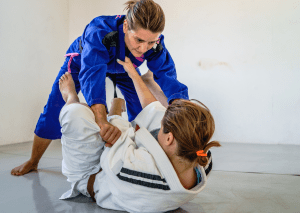
Empowerment through self-defense skills
Jiu jitsu training empowers women by teaching effective self-defense techniques. This training builds confidence and provides practical skills for personal safety. BJJ is particularly beneficial for women as it emphasizes technique over strength, allowing smaller practitioners to effectively defend against larger attackers. Women learn to use leverage and proper body position to neutralize threats, even from disadvantageous positions like being in the bottom position. The confidence gained from mastering BJJ techniques often translates into increased self-assurance in daily life.
Building a supportive network of female practitioners
Women in jiu-jitsu often find a supportive network of fellow female practitioners. This community offers encouragement, mentorship, and a sense of belonging. Many BJJ academies now offer women-only classes, providing a comfortable environment for learning and practicing techniques. Female BJJ athletes serve as role models and inspiration for newcomers to the sport. The camaraderie developed among women in Jiu-Jitsu extends beyond the mat, creating lasting friendships and support systems.
Addressing common concerns and misconceptions
Jiu-jitsu training addresses common concerns and misconceptions about women in martial arts. It emphasizes that jiu-jitsu is suitable for everyone, regardless of gender. Many women initially worry about the close physical contact in BJJ, but proper instruction and a respectful training environment help alleviate these concerns. Women quickly learn that Brazilian Jiu-Jitsu is an effective form of self-defense that doesn’t rely on brute strength. The sport also challenges the misconception that women can’t excel in combat sports, with many female practitioners achieving high ranks and competing successfully in BJJ competitions.
What Is the Impact of Nutrition on Jiu-Jitsu Training?
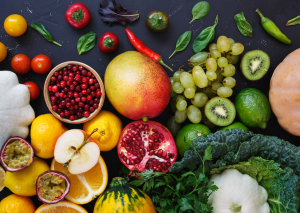
Importance of a balanced diet
A balanced diet is crucial for optimal performance in jiu-jitsu training. Proper nutrition provides the energy and nutrients needed for intense training sessions, helping to sustain energy levels and promote muscle recovery. BJJ athletes often focus on consuming a mix of complex carbohydrates, lean proteins, and healthy fats to fuel their training. Adequate nutrition also supports the immune system, which is important for consistent training. A well-balanced diet can help practitioners maintain an ideal weight for their weight class in BJJ competitions.
Pre- and post-training nutrition tips
Consuming the right foods before and after training can enhance performance and recovery. Pre-training meals should include carbohydrates and protein for energy and muscle support, while post-training nutrition should focus on protein to aid muscle repair and hydration to replenish lost fluids.
Before the training, practitioners might opt for easily digestible carbohydrates and lean proteins. After training, consuming a mix of protein and carbohydrates within 30 minutes can help kickstart recovery. Proper hydration before, during, and after training is crucial for maintaining performance and preventing fatigue.
Hydration and its effects on performance
Staying hydrated is essential for maintaining performance and preventing fatigue. Drinking enough water before, during, and after training sessions ensures that your body functions optimally and prevents dehydration-related issues. In the training, where sessions can be intense and involve significant sweating, proper hydration is crucial. Dehydration can lead to decreased performance, increased risk of injury, and slower recovery. Many BJJ athletes use electrolyte-enhanced drinks during longer training sessions or competitions to maintain proper hydration and electrolyte balance.
How Can You Track Progress in Jiu-Jitsu Training?

Setting measurable goals
Setting measurable goals is a key aspect of tracking progress in jiu-jitsu training. These goals can include mastering specific techniques, improving sparring performance, or achieving higher belt ranks. Practitioners might set goals such as perfecting their butterfly guard, improving their top game, or successfully executing a particular submission in live rolling. Goals can also include competition achievements, such as placing in a tournament or earning a certain number of positional points. Setting both short-term and long-term goals helps maintain motivation and provides a clear path for improvement.
Keeping a training journal
Maintaining a training journal allows you to document your sessions, note areas for improvement, and track your progress over time. This practice helps identify patterns and areas that need more focus. BJJ practitioners often use training journals to record new techniques learned, successful applications during sparring, and areas where they struggled. Some may include notes on specific BJJ positions they want to improve, such as escapes from side control or transitions from half-guard to more dominant positions. Regularly reviewing these notes can provide insights into progress and help guide future training focus.
Recognizing milestones and celebrating achievements
Acknowledging and celebrating milestones, such as mastering a new technique or winning a competition, is important for motivation and recognizing your progress in jiu-jitsu training. In Brazilian Jiu-Jitsu, milestones might include earning a new belt rank, successfully applying a technique in live rolling for the first time, or achieving a personal best in a competition. Celebrating these achievements, no matter how small helps maintain enthusiasm for training and provides tangible evidence of progress. Many BJJ academies have formal promotion ceremonies to recognize students advancing to higher belt ranks, which serves as a powerful motivator and celebration of hard work.
What Are the Different Styles of Jiu-Jitsu Training?
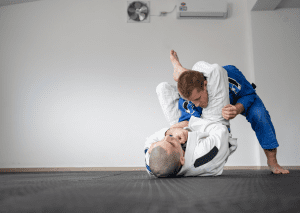
Comparing Brazilian Jiu-Jitsu to other forms
Brazilian Jiu-Jitsu (BJJ) is a martial art that focuses on ground fighting and submission holds. It differs from other forms of jiu-jitsu and martial arts, such as Japanese Jiu Jitsu, which may emphasize standing techniques and striking.
BJJ places a strong emphasis on positional control and submissions, making it particularly effective for self-defense and mixed martial arts (MMA) competitions. Unlike some other fighting styles, BJJ allows smaller practitioners to effectively defend against larger opponents by using leverage and technique. The art has evolved to include both self-defense and sport-oriented techniques, making it versatile for various applications.
Understanding Gi vs. No-Gi Training
Gi Jiu Jitsu involves training in traditional uniforms, which allows for gripping the clothing. No-Gi competitions require training in athletic wear without grips, focusing more on body control and speed. Gi jiu-jitsu incorporates techniques that utilize the gi for grips, chokes, and control, while no gi BJJ relies more on body locks and clinching.
Many practitioners train in both styles to develop a well-rounded skill set. The gi can be used to control an opponent’s body position or to execute submissions like the cross collar choke, while no gi training often emphasizes faster-paced transitions and wrestling-inspired takedowns.
Exploring specialized Jiu-Jitsu techniques
Specialized techniques in jiu-jitsu training include the butterfly guard, de la riva guard, deep half guard, and the cross collar choke. Each technique offers unique advantages and requires specific skills to master. Advanced BJJ practitioners often develop a game around specific guards or submissions that suit their body type and style. For example, the butterfly guard is excellent for sweeps and creating scrambles, while the deep half guard can be used to neutralize an opponent’s top game. Mastering these specialized techniques allows BJJ athletes to develop a unique and effective personal style.
Ready to Start Your Jiu-Jitsu Journey?
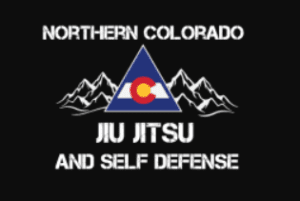
Start your Jiu-Jitsu journey today!
If you’re ready to transform your fitness and self-defense skills, now is the time to start. Whether you’re looking to improve your physical health, gain confidence, or join a supportive community, jiu-jitsu training offers immense benefits. Visit NOCO Jiu Jitsu and Self Defense to learn more about their programs and find a class that fits your needs. Don’t wait—take the first step towards a healthier, more empowered you today! Learning Brazilian Jiu-Jitsu can be a life-changing experience, offering both physical and mental challenges. As a beginner, you’ll start with fundamental techniques and basic BJJ positions, gradually progressing through the belt system from white belt to blue belt and beyond. Remember that everyone starts as a beginner, and the BJJ community is known for its supportive and welcoming nature.
In conclusion, jiu-jitsu training offers a comprehensive approach to improving both physical fitness and self-defense skills. From enhancing cardiovascular health to boosting mental resilience, the benefits are extensive. Joining a jiu-jitsu community like NOCO Jiu Jitsu and Self Defense provides support, motivation, and a sense of belonging that can enrich your training experience. Brazilian Jiu-Jitsu offers a lifelong journey of learning and self-improvement. As you progress, you’ll develop not only physical skills but also mental fortitude, problem-solving abilities, and a deep understanding of body mechanics and leverage. The friendships formed on the mat often last a lifetime, creating a global network of BJJ practitioners connected by their shared passion for the art.
Final thoughts on integrating Jiu-Jitsu into daily life
Integrating jiu-jitsu training into your daily routine can lead to significant improvements in your overall well-being. By committing to regular practice, you can develop valuable skills, build lasting relationships, and enjoy a healthier lifestyle. Embrace the journey, and you’ll find that the rewards of jiu-jitsu extend far beyond the mat. The principles learned in Brazilian Jiu-Jitsu, such as patience, perseverance, and respect, can be applied to many aspects of life. Many practitioners find that the problem-solving skills developed in BJJ translate well to their professional and personal lives. Remember that progress in jiu-jitsu is a marathon, not a sprint – consistency, and dedication are key to long-term success and enjoyment of this incredible martial art.
Frequently Asked Questions: How Can Jiu Jitsu Training Transform Your Fitness and Self-Defense Skills?
Q: What are the main benefits of training in Brazilian Jiu-Jitsu?
A: Brazilian Jiu-Jitsu offers numerous benefits, including improved physical fitness, enhanced cardiovascular health, increased strength and flexibility, effective self-defense skills, mental resilience, stress reduction, problem-solving abilities, and a strong sense of community.
Q: How does Brazilian Jiu-Jitsu differ from other martial arts?
A: Brazilian Jiu-Jitsu focuses on ground fighting and submission techniques, emphasizing leverage and technique over strength. It allows smaller practitioners to effectively defend against larger opponents and is particularly useful in close-quarters combat and self-defense situations.
Q: What equipment do I need to start training in Brazilian Jiu-Jitsu?
A: Beginners typically need a jiu-jitsu gi (uniform), a belt, and a mouthguard. As you progress, you may want to invest in additional gear such as rash guards, knee pads, and training dummies for home practice.
Q: How can women benefit from training in Brazilian Jiu-Jitsu?
A: Brazilian Jiu-Jitsu empowers women by teaching effective self-defense techniques that don’t rely on strength. It builds confidence, provides practical safety skills, and offers a supportive community of fellow female practitioners.
Q: How long does it take to progress in Brazilian Jiu-Jitsu?
A: Progress in Brazilian Jiu-Jitsu varies for each individual. Practitioners advance through a belt system, starting from the white belt and progressing through blue, purple, brown, and black belts. Consistent training and dedication are key to advancement, but it’s important to remember that everyone progresses at their own pace.
